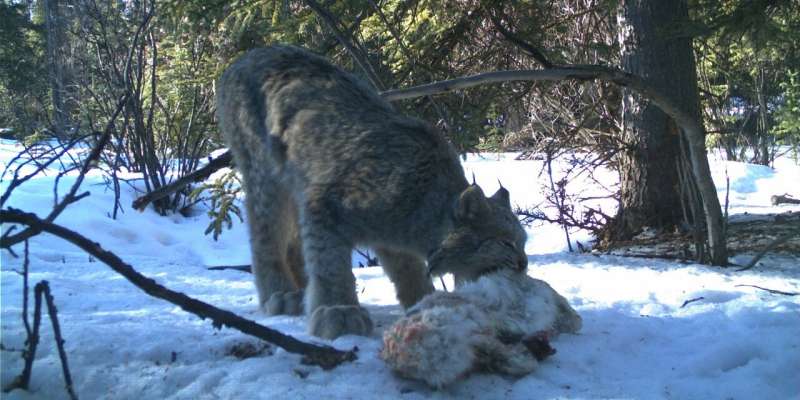Snowshoe hare carcasses feed more than usual predator suspects, study shows

Snowshoe hare carcasses may provide a vital food source for a wide variety of species in Canada's boreal forest—including lynx, ravens, flying squirrels and even other hares, according to a new study by University of Alberta ecologists.
"This is one of the most diverse scavenger communities recorded," said post-doctoral researcher Michael Peers, who conducted the research during his Ph.D. studies under the supervision of U of A biologist Stan Boutin.
The researchers examined the northern boreal forest in the Yukon from 2015 to 2018. Using remote sensing cameras, they observed which animals scavenged from nearly 100 opportunistically placed snowshoe hare carcasses throughout the region.
They documented 24 different species feeding from the carcasses.
"Species we may think of as scavengers like common ravens, magpies and wolverines were recorded, but also species that people might not expect to be scavengers," Peers noted. "We documented snowshoe hares, Canada lynx, red squirrels, northern flying squirrels, Arctic ground squirrels and chipmunks all scavenging."
Peers said the results indicate prey species may have a more complex impact on food webs than previously thought, because their numbers influence both their direct predators and other animals that commonly scavenge.
"Scavenging by animals is often overlooked in food web research," he explained. "Our data show that a lot of species scavenge in the boreal forest of Canada, and that changing temperatures or the abundance of keystone species can impact scavenging communities."
The study, "Prey Availability and Ambient Temperature Influence Carrion Persistence in the Boreal Forest," was published in the Journal of Animal Ecology.
More information: Michael J. L. Peers et al. Prey availability and ambient temperature influence carrion persistence in the boreal forest, Journal of Animal Ecology (2020). DOI: 10.1111/1365-2656.13275
Journal information: Journal of Animal Ecology
Provided by University of Alberta



















